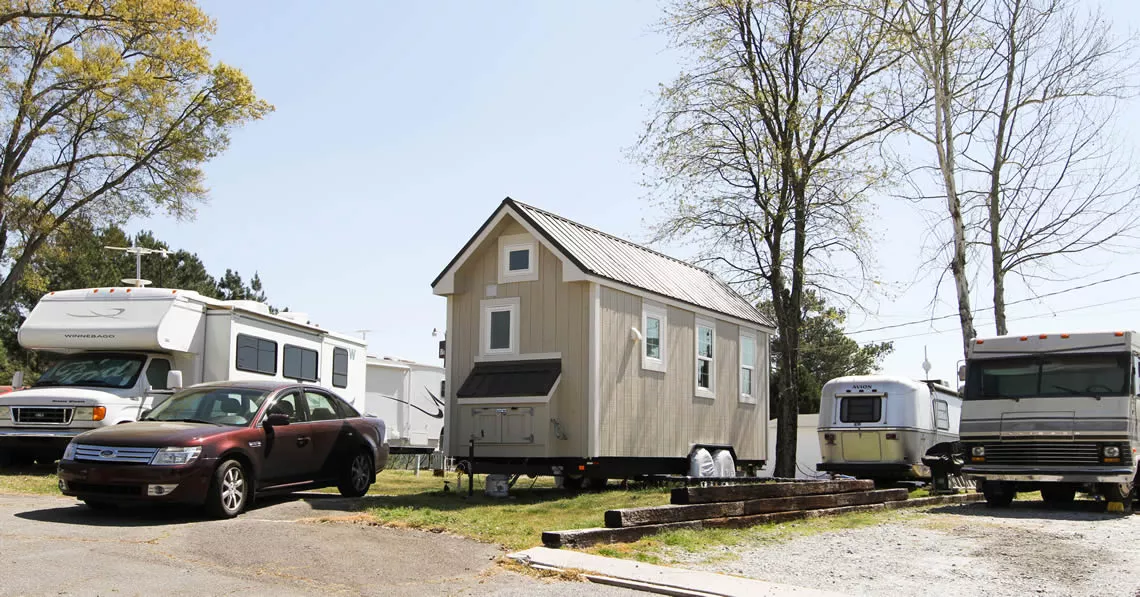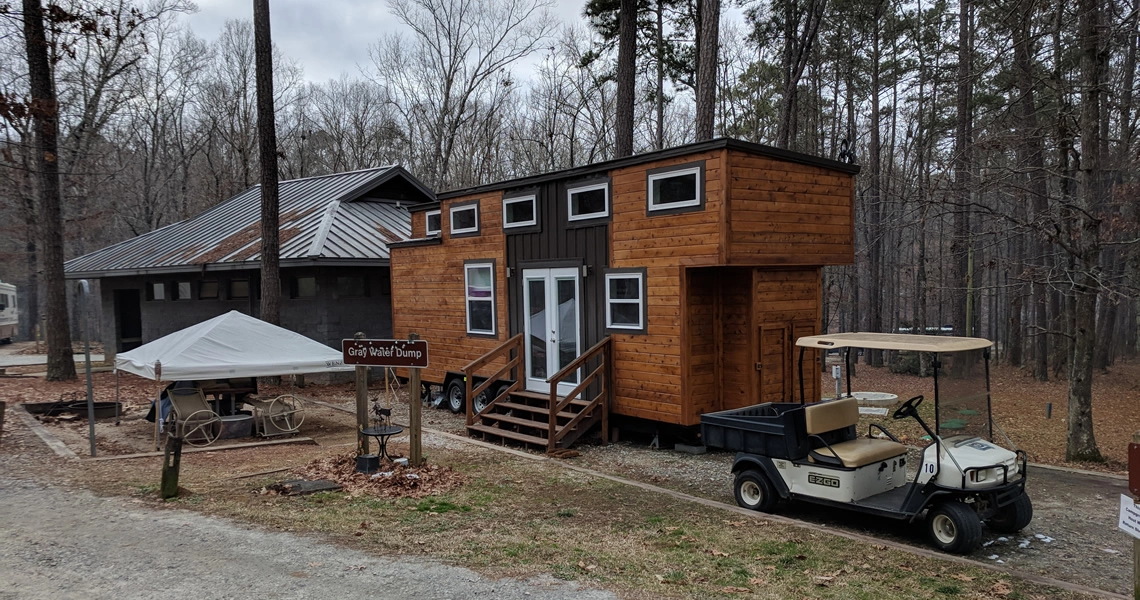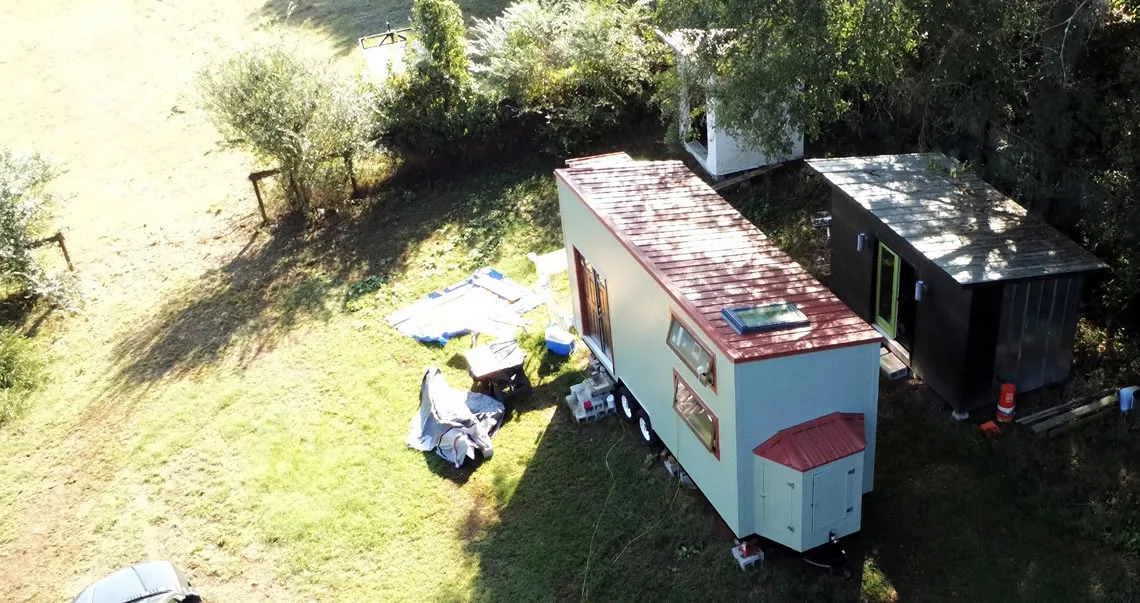If you have done any research into tiny houses on wheels, the question “where can you park and live in a tiny house?” has surely come up. The problem with this question is that there is no definitive answer. The rules, codes, and laws vary from state to state, county to county and sometimes even town to town.
Needless to say, it’s a bumpy road ahead to navigate. But with proper planning, clear communication, and a little luck, you can succeed in your search. So, let’s get started helping you find the perfect place to live in your tiny house.
Terms and Classification
Because tiny houses don’t typically have their own classification, how they are classified varies. Many jurisdictions consider them to be recreational vehicles (RVs), while others may consider them to be mobile homes or even accessory dwelling units (ADUs). Some jurisdictions do recognize them as tiny houses, but that may be just to prohibit them.
It is important to understand the different terms and classifications that your home may or may not be placed in. Many of the rules that govern structures and housing have been established for a long time with only incremental changes over the years. When a new housing option comes along like tiny houses, which is rare, governing bodies either need to fit it into an existing classification to determine which rules apply or create a new classification and new rules.

A tiny house in an RV park
Existing Classifications
Trailer
For the most part, any semi-trailer, boat trailer, utility trailer, flatbed trailer, box trailer or horse trailer is considered to be just that – a trailer. Since most tiny houses are built on trailers, they are frequently initially registered only as a trailer. The reason for this is the lower yearly fee to register and renew a trailer versus an RV. But this is just to keep the trailer legal, as many locations require all vehicles and trailers to be tagged. If you decide to live in your tiny house by flying under the radar (more on this later), this is probably how you will want to register your tiny house. But to be clear, having a tag says nothing about a vehicle’s livability.
RV
A Recreational Vehicle (RV), or Park Model, is typically a vehicle that is meant for temporary accommodation, for instance, while camping. In most locations these are not allowed to be lived in. Lived in is typically defined as staying in a structure continuously for more than 30 days. When many people hear this, they think it is a giant loophole. After all, how does anyone know if you have lived in something for more than 30 days. No one is continuously monitoring your movements (you hope). Perhaps you left for a few days, how would they know? Unfortunately, in our experience, it’s up to the individual code enforcement inspector to decide if you are living in a structure or not. If they say you are, it can be hard to convince anyone otherwise. However, that is not to say that there aren’t thousands of people living in RV’s full-time. Some places are extremely accommodating to them. Most RV parks have large sections reserved for full-timers, even though it typically isn’t legal there as well. It’s just that no one cares if people are living in an RV in an RV park. If it’s in the driveway of an affluent neighborhood, suddenly people care.
Mobile Home
A mobile home is built on a trailer and designated for full-time living, so some people try to seek this classification. However, mobile homes in the US are regulated by the U.S. Department of Housing and Urban Development (HUD) and have a minimum size requirement of 400 sq. feet. This is larger than even some of the largest tiny houses. Mobile homes are also required to have their tires (and sometimes the trailer tongue) removed and be secured to the ground when parked, which is not always desirable or possible for a tiny house.
Shed
A shed is a small backyard structure that is on a foundation. Sheds under a certain size typically don’t require a permit to be built. However, while sheds can have power run to them, they generally are not allowed to have plumbing. Once a shed has plumbing, it is considered a dwelling. Since sheds are built on a foundation, a tiny house on wheels (THOWs) isn’t usually classified as one.
Accessory Dwelling Unit
An Accessory Dwelling Unit (ADU) is a secondary house or apartment with its own kitchen, living area, and separate entrance that shares the building lot of a larger, primary house. In most places there are separate laws and codes governing them and they usually need to be on a foundation. In some locations, people are also prohibited from renting them out as they are solely designated to care for loved ones. Since ADU’s are mostly on a foundation, a tiny house on wheels (THOWs) isn’t usually classified as one.
As with all the classifications above, every town has a different way of looking at these vehicles/residences and will occasionally add additional qualifications onto them to more stringently define them.
New Classification
Some individuals are pushing for legislative change to introduce a new classification specifically for tiny houses. This makes the most sense, since none of the existing classifications are a great match for tiny houses. While this approach is preferred by many, it is also the most challenging. The amount of work required to do so is not a task most government agencies are up for taking on.
Homeowner Considerations and Challenges
Not that we’ve gone through the different classifications, lets discuss the different considerations and challenges that people sometimes face when trying to live in a tiny house.
Square Footage
The International Building Code (IBC) used to have a minimum size requirement for rooms, however, that has since been removed. Unfortunately, that doesn’t mean that individual municipalities don’t have their own requirements concerning size. The arguments for these rules are usually centered around safety and population density, but most certainly the lower tax revenue of smaller housing plays a part. If you want a tiny house on a foundation, you will likely need to get a variance for the minimum square footage. If building on a trailer, the minimum square footage rules don’t apply.
Mobile vs Permanent
Most municipalities will only permit or inspect permanent structures. While mobility is one of the huge benefits of tiny houses, tiny and small houses on foundations are the ones making the most progress towards getting legislative approval. This is for good reason as mobile housing is difficult to plan for when it comes to infrastructure. If you don’t ever plan to move your tiny house, you might consider building on a foundation if allowed. If smaller housing is not permitted, a tiny house on wheels may be your only option.
Inspections
If your tiny house is built on a foundation, it is subject to all the local building codes. These codes are in place to make sure there is a minimum quality and safety standards that these homes are being built to. If you are building on a trailer, there isn’t typically a governing body who needs or wants to inspect your home. However, that doesn’t mean you shouldn’t follow the rules. The building codes are there to keep you safe. Over the years we’ve seen homes built to all ranges of quality and safety. Before building your houses, be sure to do your research.
Legislature Concerns and Motivation
The reasons that a local government may not want tiny houses can vary from legitimate concerns to unfounded fears. Understanding what those are can help you to prepare to alleviate them.
Taxable Square Footage
We touched on this earlier. The town, county and/or state loves tax revenue. It is what allows them to stay open for business. Minimum square footage laws may be in place to make sure that they are keeping that revenue up. If you build a smaller house, you’ll pay less in taxes. Or, if you bring a moveable trailer onto a piece of property, they can’t tax that at all (it’s not an improvement to the land). Skipping taxes is not the goal of most tiny house dwellers we’ve talked to. After all, they are using the resources provided by their community (roads, schools, etc.), and they feel it is fair to contribute to the cost of those resources.
There are many solutions to bring to the local legislature including paying tax for your tiny house as if it was on a foundation or perhaps agreeing to pay the minimal square footage tax. For example, if the minimum square footage was 500 sq. ft. then you would pay the equivalent of that amount instead of for the 284 square footage that you have. While this sounds great in theory, we have not heard of many people being successful in this approach.
Population Density
There are some places that have a serious population density issue regarding infrastructure and traffic. The concern is that if they change the law and allow tiny houses, there is the potential to be twice as many or more people living in that particular area. For this reason, blanket changes and approvals are less likely. The success stories that we have seen usually involve a variance for a very specific area or lot. This approach allows lawmakers to test and limit any impacts of higher density housing.
Shanty Town
Many local governments have been actively trying to reduce or eliminate mobile home parks from their communities. The concern for some in government is that adopting tiny house communities could undo some of the progress in that area. After all, from the outside, a community of tiny mobile houses sounds a lot like a mobile home park. Educating and reassuring legislatures on the difference between the two is normally required to get approval for more than a single unit.
Town Safety
“You’ll burn down the whole town!” Ok, that may be an exaggeration, but there are plenty of building inspectors that are not fans of tiny houses because there is so little regulation. Anyone, anywhere can do the electrical and plumbing within them and not need to be inspected. And truth be told, there is some shabby work done out there. There are already towns seeing their way past this with the solution of inspections. In Savannah, GA, they are inspecting a 75-home tiny house community for electrical and plumbing before they allow them onto the property where they will be parked. This is a big reason of why I tell everyone who builds a tiny house, both commercially or personally, to take a video diary of the build. That way you may not need to rip apart the walls to pass an inspection down the road if you decide to move to a community that requires them.
Homeowner Approaches
Now that you understand the challenges you may face and the motivations of the gatekeepers, you have a choice. Do you face them head on and try to get approval, or do you fly under the radar and hope for the best?
Acceptance
If you are the type of person who is only comfortable staying exactly within the lines of civilization, you will want to seek approval for your tiny house before buying or building it. This process will likely involve finding a plot of land where you want to live, and then approaching the local zoning department with your request. You will need to identify the specific rules that you will be violating, if any, and then request a variance. This is a multi-step process that will culminate in standing behind a podium while presenting your case to a board. Also, be prepared to lay out some money, as there is a fee collector at every stage.
Flying Under the Radar
Most people who live in tiny houses have at least a little bit of a rebel streak within them. After all, tiny houses are anything but mainstream. So, it should be no surprise that most tiny home dwellers are doing so without implicit approval from their local government. This can be easier to accomplish and be more successful in less conspicuous locations (we’ll talk about those next).
You will only want to consider this option if your house is on wheels, since the worst-case scenario is that you need to move your home. If your house is on a foundation and built without permission, the government can forcibly remove your home (think bulldozer).
Locations
RV Parks
RV parks may not be your first choice, but do your research before you dismiss them. Many private RV parks are making special accommodations for tiny houses and grouping them together, essentially making small tiny house communities within them. Even if the RV park doesn’t have other tiny houses, they most definitely have full-time RVers living there. This is a less transient group which can provide more of a feeling of community. Also, while it’s usually not legal to live in an RV even in an RV park, don’t expect anyone to bother you there.
Public RV parks, like those found in state parks, are much stricter about how long an RV, or tiny house, can stay in one location. The exception however is made to campground hosts. Campground hosts live in state parks and provide some services while there, for instance selling firewood or cleaning the bathrooms. In exchange, campground hosts are permitted to park in a spot for free for as long as they are a host.

A tiny house in a state park
Tiny House Communities
Tiny house communities are areas that are designated for tiny houses. We go into quite a few examples later in this article. But as you go through the list, you’ll find that many are actually RV or mobile home parks that have either renamed or rebranded themselves. There are a few that are dedicated to only tiny houses, but those are rarer.
Towns that are Accepting of Tiny Houses
A few towns in the US have openly adopted tiny houses. There motivations for doing so can range, but it’s usually to bring more people into an area that is suffering from population attrition. One of the most famous examples is Spur Texas. They initially invited any style of housing but have since restricted it only somewhat. I watched an interview with a town representative who said all were welcome, accept anarchists and nudist! (which I thought must have a funny backstory)
Towns that are accepting of anything
There are many towns and rural areas in the US that don’t have many, if any, rules concerning what can be built. And not all these locations are remote. For instance, you don’t have to get too far outside cities such as Chattanooga Tennessee or Asheville North Carolina before the rules start to shed away. Some of these counties don’t even have building departments. My uncle lived in Tennessee recently and when he went to inquire about a building permit they only wanted to see a drawing (not plans, a pencil drawing), of what he wanted to build. He walked out with a building permit ten minutes later.
Rural or Inconspicuous Locations
Even if you are closer to a city or in an area that is more restrictive, if your house is inconspicuous, you can get away with a lot. Code enforcement is primarily complaint driven. If no one sees your house or complains about it, you can likely live in your home for a long time undisturbed. ‘A friend of mine’ has several tiny homes on acreage in an area that does not permit tiny houses, but they have been occupied for years.

Tiny houses on rural land
Best Practices
Be a Good Neighbor
Regardless of the approach you take, you’ll want to be a good neighbor. As previously mentioned, code enforcement is complaint driven. So, don’t do anything to upset your neighbors.
Also, make sure to inform your neighbors of your plans before moving a tiny house onto your property. For instance, if you plan to put a tiny house in your backyard, make sure those around you know your intentions. If they don’t know, they may assume the worst (the house is the first of 10) and want to stop you before it gets bad.
Don’t Be Combative
If a code enforcement officer does show up to question you about your tiny house, be friendly. It’s easy to think of someone in their position as the opposition that you must defeat. But they are just doing their job and it is in no way personal. When my mom lived in a tiny house, code enforcement often showed up at her house to verify that she wasn’t living in it. She was! But because she was friendly (and made them cookies) they guided her in a way to avoid her having to change anything.
So as you can see, “Where can I park my tiny home?” is a complicated and almost unanswerable questions, right now. But keep the faith! “The Tiny House Movement” is here to stay so local regulatory officials will eventually have to address the laws governing the construction and placement of them in our communities. As in most powerful and popular grassroots movements, the government usually has to get on board and make accommodations.
Tiny House Communities

Share this Image on your Website
View our Tiny House Community Directory to find a community in your area.